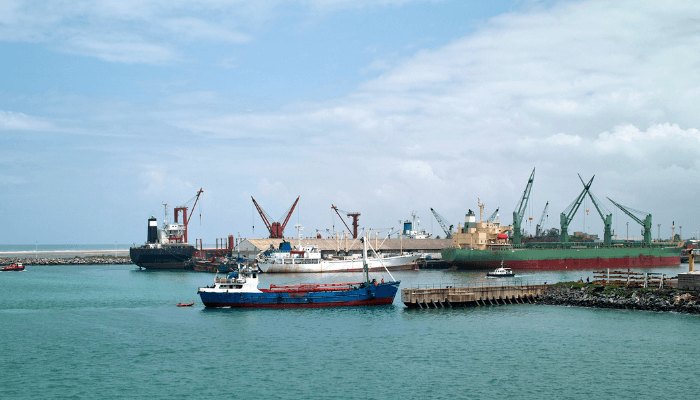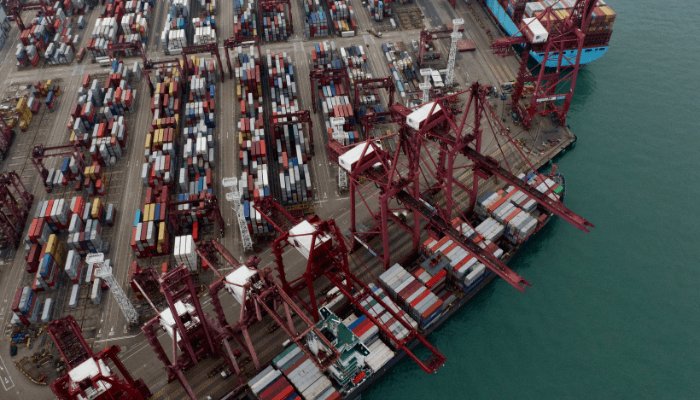2 Major Ports of Togo
The West African country of Togo is bordered by Ghana, Benin and Burkina Faso. Covering 57,000 square kilometres, its territory extends to the Gulf of Guinea, where its major port is located. Togo is one of the smallest countries in Africa, possessing a tropical climate.
Agro-based products comprise a majority of exports. Cash crops like coffee, tea, cocoa, beans and peanuts generate more than 25 per cent of export earnings. The country has fertile lands in abundance; hence cotton is also grown. Major cereals are cassava, rice, barley and maize. Other vital sectors include breweries and textiles. Manufacturing and industries are at a primitive stage in Togo.
The country produces only a third of its electricity; hence the remaining need is fulfilled through electricity importation from Ghana and Nigeria. This has badly affected the economy as the nation is forced to produce less.
One of the least developed countries, Togo has witnessed some economic and infrastructural growth in the last two decades, owing to the efforts of the World Bank and the IMF. The country was riddled with political strife and a lack of skilled workforce which arrested economic growth.
Today, Togo is on the path of modernisation and has emerged as a regional trade hub. It introduced economic reforms and liberalisation, which has helped the economy flourish.
The nation imports machines, heavy equipment, petroleum and foodstuff from the Netherlands, France, Italy, Germany, South Africa and China. On the other hand, agro-based items like coffee, cocoa, phosphates and cotton are shipped to Mali, China, the Netherlands and Burkina Faso.
Togo has two major ports- the Port of Lome and the port of Kpeme. These facilities operate at their optimum capacity to drive the country’s economy. Check out the ports of Togo in this article.
1. Port of Lome
Lome is five nautical miles off the coast of Lome city, on the West Coast of Africa, just 23 nautical miles from Cape Saint Paul. It is Togo’s capital and premier port, serving as a regional transportation and commercial centre. The port has several facilities for accommodating general cargo, breakbulk, container goods, RORO and oil tankers. It also functions as a transhipment hub for landlocked nations of Niger, Mali and Burkina Faso. Togo port handles more than 15.5 million tonnes of annual cargo traffic.

Lome is the principal seaport of Togo, dealing with more than 80 % of its international maritime trade. It was constructed in the 1900s and has transformed from a wooden pier to a modern harbour in the past few years. Continuous investments in port infrastructure and the government’s liberalisation policy aided Lome’s growth as the principal deepwater port of Togo.
Port modernisation has created over 500 jobs for the people. The port authorities also launched a scheme for training the newly recruited personnel.
Port Specifications
All berths are protected by two dykes, measuring 1720 and 950 metres, preventing the harbour from silting. Loading and unloading operations are undertaken 365 days of the year, and 24/7 berthing facilities are available.
The harbour has a 63 m long tug wharf for berthing tug boats. The fishing port was opened in 2019 and had a landing quay. It can accommodate 300 canoes and consists of a large auction hall, an administrative building, two ice plants, three cold storages, three fishmongers, a mooring, a waste handling plant, water tanks, restrooms, a police station and the latest equipment.
Lome has a 250 m tanker berth for 10,000 DWT tankers with a 270 m LOA and a 14 m draught. The ore wharf comprises a 215 m long berth for receiving ore and bitumen carriers. Pier 1 has a 367 m quayage area with four berths for conventional cargo. The 255 m berth is reserved for container carriers.
The 3rd platform measures 450 m lengthwise and has a water depth of 15 m. It has two piers which receive ships containing approximately 7000 20 ft containers. The terminal has a 35-hectare storage area, two quay gantries and 4 RTG.
Container terminal
Operated by Bollore ports, the container terminal comprises 1050 m of linear quay with a depth of 16.7 m. It has five operational berths and can accommodate around 14,500 containers with a height of 20ft. Bollore ports aim to transform Lome into a significant transhipment platform having international standards.
Endowed with the Oscar terminal operating system, the port can handle 1,100,000 TEUs and has a 10,000 TEU storage capacity.
The container yard was expanded from 12 hectares to 35 hectares in 2018. Around 53 hectares are dedicated to container storage. It has over 18 reefer connections and the latest port equipment, including nine gantries, 26 RTG cranes, two mobile harbour cranes and 19 reach stackers.
Storage facilities
The free port has 115,000 m2 of sheltered storage space for different companies operating at Lome harbour. A small shopping complex is situated on the port premises. Additionally, the Togolese Storage Company has huge tanks for storing hydrocarbons.
Over 200,000 m2 of land was reclaimed for storing containers and miscellaneous cargo such as building material and equipment.
Lome port has numerous parking lots for port trucks and other vehicles. It has a 600,000 m2 parking lot used by trucks and a 13,000 m2 car parking zone. To facilitate loading operations, a 20,700 m2 car park is close to the roundabout to prevent congestion. A 31,000 m2 area is designated for unloading containers. The Sahel terminal spans 40,000 m2 and accommodates trucks bound for Mali, Niger and Burkina Faso.
Advantages of Lome
Lome is the only deepwater seaport on the West African coastline that can accommodate new generation vessels. The harbour benefits from a significantly low tidal range and not-so-strong winds, making Lome safe and easily accessible.
Lome is located at the crossroads of important trade routes and is the only West African port which connects numerous cities and capitals of the region. It provides the advantage of transporting cargoes via roadways within 24 to 48 hours, a small timeframe and at competitive prices.
It is also the only West African port recognised by ECOWAS as a free trade zone. Cargo is handled and transported without stringent custom regulations, saving valuable time. Also, the administrative formalities are simplified for operators and clients.
The Free trade Zone contains many industrial production units. The port covers more than 900 hectares of land, including the adjacent industrial zone, which houses over 15 prominent companies that gain from quality infrastructure, viable economic regulations and fiscal benefits.
2. Port of Kpeme
The second busiest port in Togo is Kpeme, around 23 miles northeast of Lome. It handles shipments of phosphates and breakbulk. The largest vessel handled here was the Atlantic Sovereign, measuring 68,642 DWT with a draught of 12.7 m. Approximately 2,000,000 tonnes of cargo pass through the port annually.
The loading pier can accommodate carriers with a maximum LOA of 225 m, 33 m beam and an 11.9 m draught. Due to excessive swell, the tanker berth welcomes vessels with an overall length of 180 m and a maximum permissible draught of 11.8 m.

The port contains three railway bridges made of concrete. It has an 850 m long steel railway bridge covering the Lake Togo coast. Also, the waterfront facilities for handling phosphate include a 1250 m steel bridge used for transporting phosphate through conveyor belts, a large platform with a station, three ship-loading machines and three mooring dolphins. The infrastructure is regularly checked and maintained.
You might also like to read:
- 7 Major Ports of South Africa
- 6 Major Ports in Nigeria
- 5 Major Ports of Somalia
- 7 Major Ports and Terminals in Djibouti
- 5 Major Ports in Tanzania
Disclaimer :
The information contained in this website is for general information purposes only. While we endeavour to keep the information up to date and correct, we make no representations or warranties of any kind, express or implied, about the completeness, accuracy, reliability, suitability or availability with respect to the website or the information, products, services, or related graphics contained on the website for any purpose. Any reliance you place on such information is therefore strictly at your own risk.
In no event will we be liable for any loss or damage including without limitation, indirect or consequential loss or damage, or any loss or damage whatsoever arising from loss of data or profits arising out of, or in connection with, the use of this website.
Do you have info to share with us ? Suggest a correction
Disclaimer :
The information contained in this website is for general information purposes only. While we endeavour to keep the information up to date and correct, we make no representations or warranties of any kind, express or implied, about the completeness, accuracy, reliability, suitability or availability with respect to the website or the information, products, services, or related graphics contained on the website for any purpose. Any reliance you place on such information is therefore strictly at your own risk.
In no event will we be liable for any loss or damage including without limitation, indirect or consequential loss or damage, or any loss or damage whatsoever arising from loss of data or profits arising out of, or in connection with, the use of this website.

About Author
Zahra is an alumna of Miranda House, University of Delhi. She is an avid writer, possessing immaculate research and editing skills. Author of several academic papers, she has also worked as a freelance writer, producing many technical, creative and marketing pieces. A true aesthete at heart, she loves books a little more than anything else.
Latest Maritime Knowledge Articles You Would Like:
Subscribe To Our Newsletters
By subscribing, you agree to our Privacy Policy and may receive occasional deal communications; you can unsubscribe anytime.















